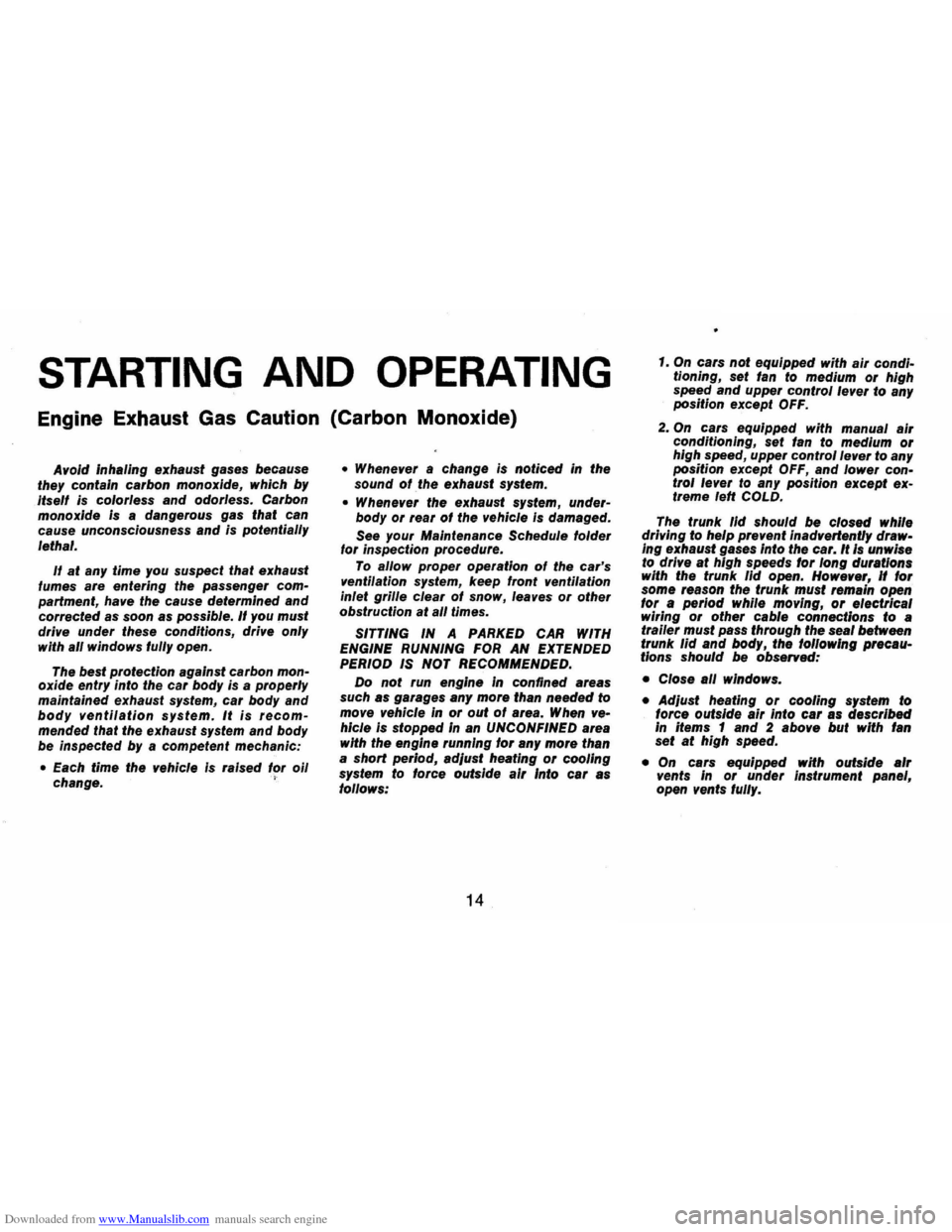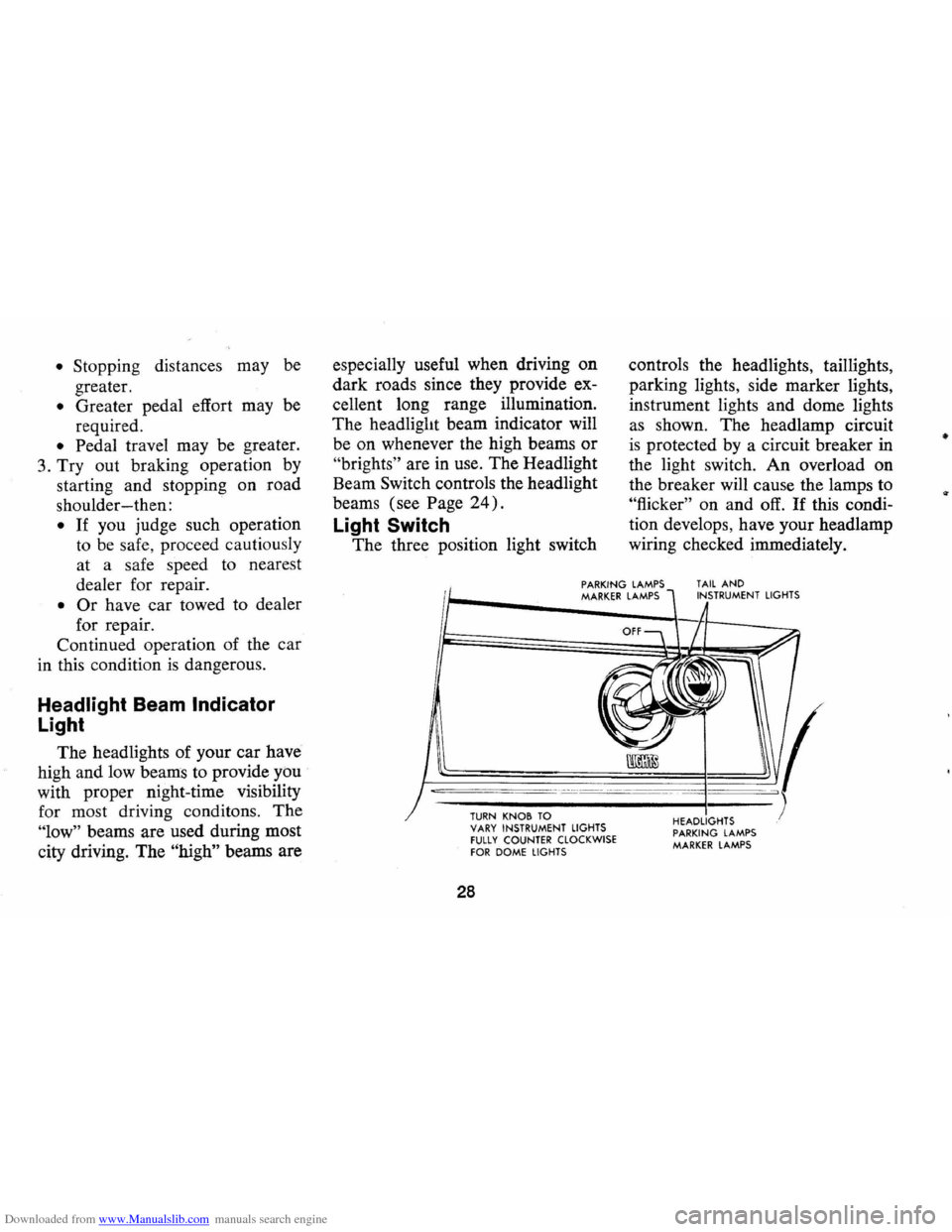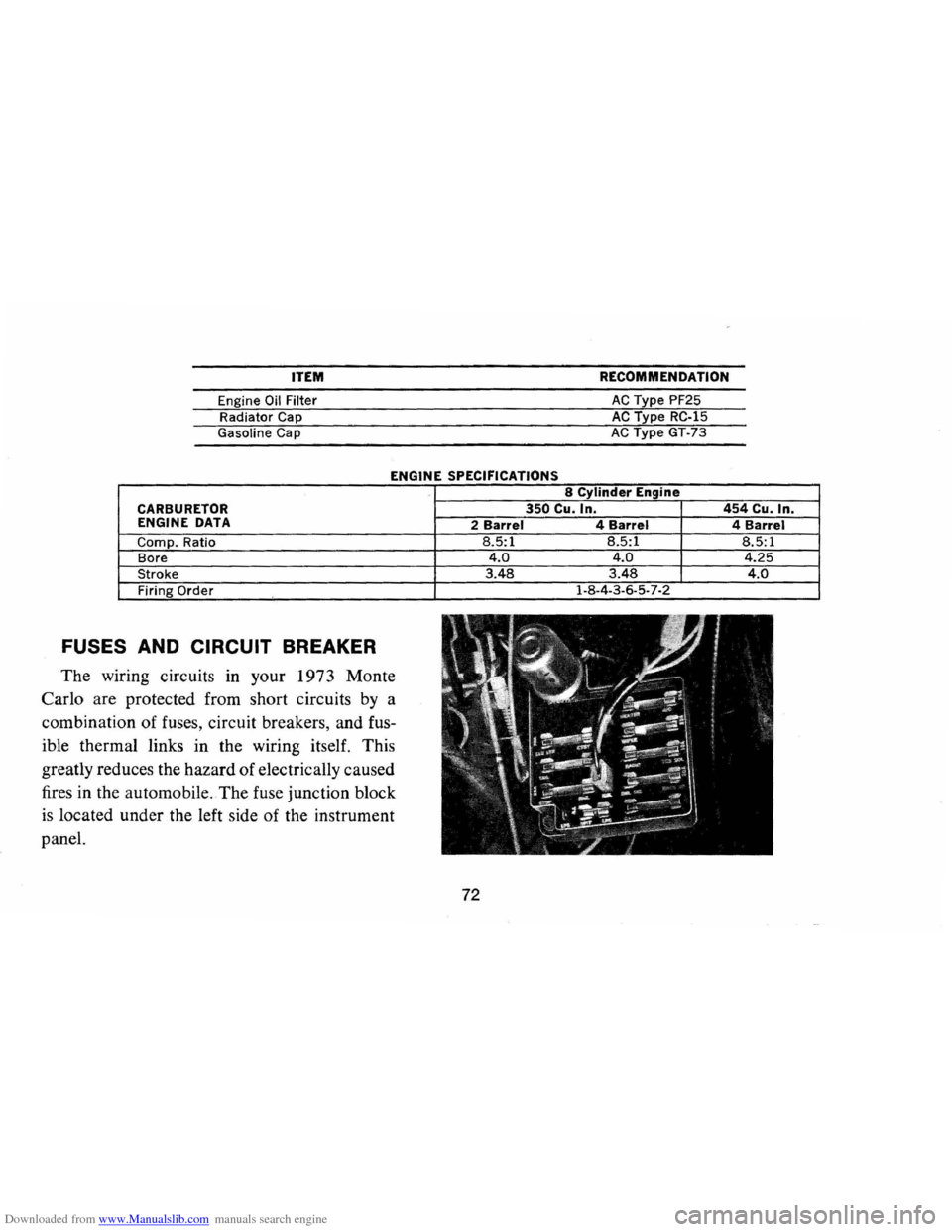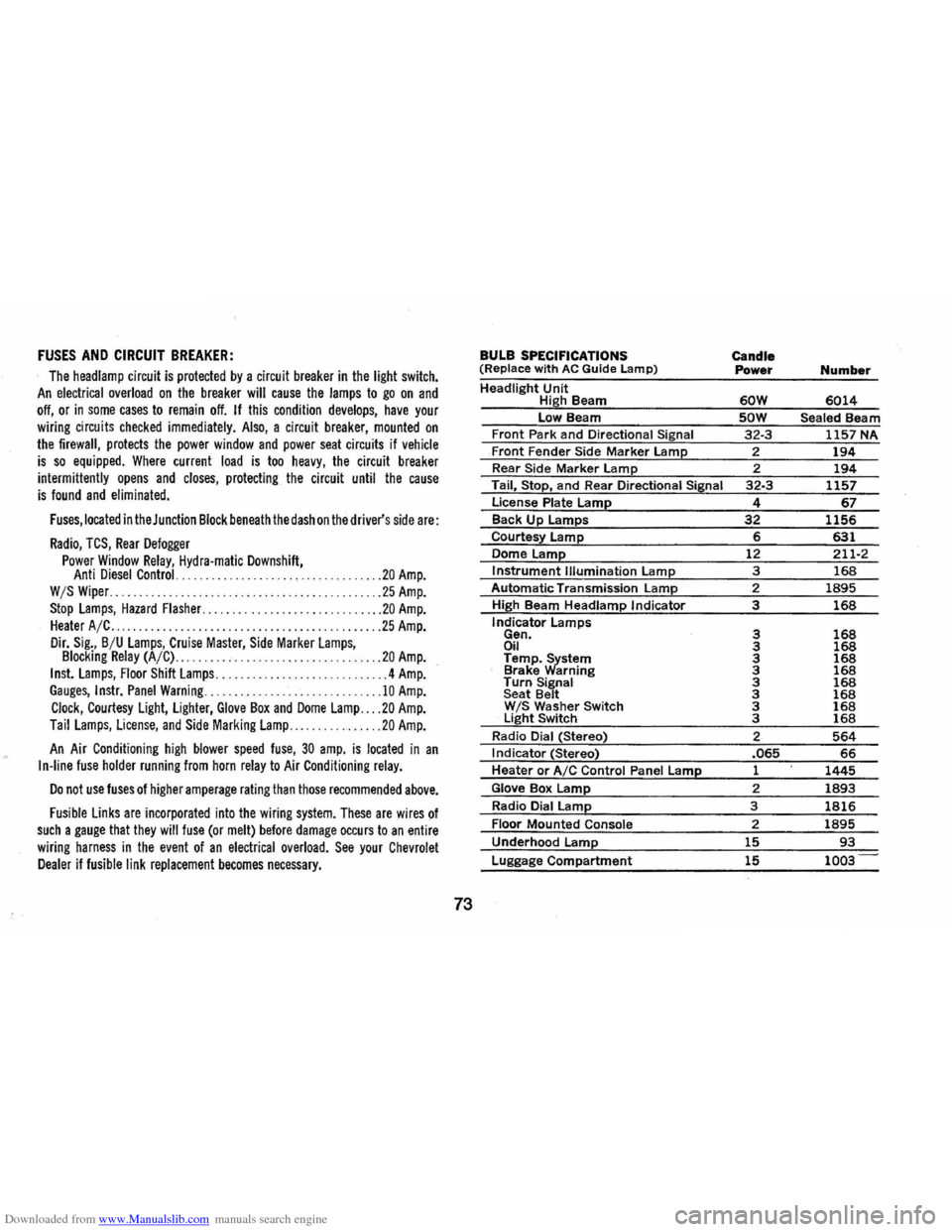1973 CHEVROLET MONTE CARLO wiring
[x] Cancel search: wiringPage 16 of 86

Downloaded from www.Manualslib.com manuals search engine STARTING AND OPERATING
Engine Exhaust Gas Caution (Carbon Monoxide)
Allold inhaling exhaust gases because
they contain carbon monoxide, which by
Itsell is colorless and odorless. Carbon
monoxide is a dangerous gas that can cause unconsciousness and is potentially
lethal.
II at any time you suspect that exhaust fumes are entering the passenger compartment, have the cause determined and corrected as soon as possible. II you must
drive under these conditions, drive only
with
all windows fully open.
The best protection against carbon
monoxide entry into the car body is a properly
maintained exhaust system, car body and body ventilation system. It is recommended that the exhaust system and body
be inspected by a competent mechanic:
• Each time the IIehicie is raised for oil change. > •
Wheneller a change
is noticed In the
sound of the exhaust system.
• Wheneller the exhaust system, under
body or rear of the vehicle is damaged.
See your Maintenance Schedule folder
for inspection procedure.
To allow proper operation of the car's
IIentilation system, keep front ventilation
inlet
grille clear of snow, leaves or other obstruction at all times.
SITTING IN A PARKED CAR WITH
ENGINE RUNNING FOR AN EXTENDED PERIOD IS NOT RECOMMENDED.
Do
not run engine in confined areas such as garages any more than needed to mOlle IIehicle In or out of area. When IIehlcle is stopped In an UNCONFINED area with the engine running for any more than a short period, adJust heating or cooling system to force outside air Into car as follows:
14
1. On cars not equipped with air condi
tioning, set fan to medium or high
speed and upper control leller to any
position except OFF.
2. On cars equipped with manual air conditioning, set fan to medium or high speed, upper control lever to any
position except OFF, and lower control lever to any position except extreme left COLD.
The trunk lid should be closed while
drilling to help prellent inadllertently drawIng exhaust gases Into the car. If Is unwise to drive at high speeds for long durations
with the trunk lid open. Howeller, If lor some reason the trunk must remain open lor a period while mOiling, or electrical wiring or other cable connections to a trailer must pass through the seal between
trunk lid and body, the lol/owlng precau
tions should be observed:
• Close all windows.
• Ad/ust heating or cooling system to
force outside air into car as described In items 1 and 2 abolle but with Ian set at high speed.
• On cars equipped with outside aIr IIents In or under Instrument panel, open IIents lully.
Page 30 of 86

Downloaded from www.Manualslib.com manuals search engine • Stopping distances may be
greater.
• Greater pedal effort may be
required .
• Pedal travel may be greater.
3.
Tryout braking operation by
starting and stopping on road
shoulder -then:
• If you judge such operation
to be safe , proceed cautious
ly
at a s afe speed to nearest
dealer for repair.
• Or have car towed to dealer
for repair.
Continued operation of the car
in this condition
is dangerous.
Headlight Beam Indicator
Light
The headlights of your car have
high and low beams to provide
ybu
with proper night-time visibility
for most driving conditons . The
"low" beams are used during most
city driving. The "high" beams are especially
useful when driving
on
dark roads since they provide ex
cellent long range illumination.
The headlight beam indicator will
be on whenever the high beams
or
"brights" are in use. The Headlight
Beam Switch controls the headlight
beams (see
Page 24).
Light Switch
The three position light switch controls
the headlights, taillights,
parking lights, side marker lights,
instrument lights and dome lights
as shown. The headlamp circuit
is protected by a circuit breaker in
the light switch. An overload on
the breaker will cause the lamps to
"flicker" on and off. If this condi
tion develops, have your headlamp
wiring checked immediately.
PARKING LAMPS MARKER LAMPS TAIL AND INSTRUMENT LIGHTS
--,---.---~------ -- --------
TURN KNOB TO VARY INSTRUMENT LIGHTS fULLY COUNTER CLOCKWISE fOR DOME LIGHTS
28
HEADLIGHTS PARKING LAMPS MARKER LAMPS
•
Page 72 of 86

Downloaded from www.Manualslib.com manuals search engine as a screwdriver handle or pliers. Replace the oir cleaner and attempt to start the engine in the normal manner. (E) If the car will start but stalls when hot or has a rough idle, you can suspect a faulty IDLE ADJUSTMENT, a malfunctioning AUTOMATIC CHOKE or an extremely dirty and blocked AIR CLEANER ELEMENT. Replace paper element air cleaner if necessary. Idle adjustment or automatic choke service (other than that outlined in paragraph 0 above) should be performed by your Chevrolet
Dealer. If the above Fuel System checks and the checks suggested under
the Electrical System following do not correct the malfunction, it is recommended that you turn to your Authorized Chevrolet Dealer
for further checks, adjustments or repairs. ELECTRICAL SYSTEM If when the ignition key is turned to "Start", the engine will not turn' over, yOu have good reason to suspect electrical trouble. NOTE: Never'remove Delcotron bat lead without first disconnecting battery ground cable. IF) When there is no response at all to attempts to start the car,
check the obvious-your AUTOMATIC TRANSMISSION SELECTOR LEVER must be in Neutral or Park position (manual transmission
must have clutch depressed all the way to floor) before the engine
can be starfed. Turning the IGNITION SWITCH rapidly back and forth several times will sometimes correct a poor internal switch
contact.
(GI The BATTERY may be discharged. If so, lights will be dim and the horn will have a poor tone if it will blow at all.
Usually a garage recharge will be necessary to return the battery to operation. Occasionally, however, a long drive will recharge the battery. . , •
NOTE: If the baHery is determined to be dead, and for no apparent reason, have your :Aflthori~ed Chevrolet Dealer check the baHery, the GENERATOR and the VOLTAGE REGULATOR.
GENERATOR trouble shqiJld already have been indicated by
69
the generator indicator light on the instrument panel.
POOR BATTERY CONNECTIONS may be suspected if the car has operated properly a short time before and now not even the horn will operate. Check both ends of both battery cables. If the connections are corroded, a car may sometimes be restored to operation by removing all cable ends, scraping all contacting surfaces
clean with a pen knife, and reassembling. If the cables are broken,
they must be replaced. The power supply should now be restored unless-the battery is dead.
(HI If, however, the lights and horn work properly but the starter will still not turn over, check the STARTER connections. A "click" from the starter solenoid indicates that the wiring to the starter is properly installed. If the wiring seems to be clean and tightly installed, the trouble is probably in the starter itself and should be referred to your Authorized Chevrolet Dealer.
When the engine will "turn over" but will not start, the following
items may be checked along with the Fuel Systems Checks listed previously.
(II With a clean dry cloth wipe the ce-amic portions of the spark plugs dry. In particularly damp or rainy weather dampness may be the cause of not starting, espe
cially when the engine is cold.
(JI Check the cables at the top
of the distributor and coil as well as each spark plug cable for
tightness.
(KI If the car will still not start,
check for spark at the spark plugs in the following manner: Pull one of the spark plug
wires off its spark plug. Insert a
short piece of bare wire (such as Distributor and Coli Cables
Page 75 of 86

Downloaded from www.Manualslib.com manuals search engine ITEM RECOMMENDATION
Engine Oil Filter AC Type PF25
Radiator
Cap AC Type RC-15
Gasoline Cap AC Type GT-73
ENGINE SPECIFICATIONS
CARBURETOR ENGINE DATA
Compo Ratio
Bore
Stroke
Firing
Order
FUSES AND CIRCUIT BREAKER
The wiring circuits in your 1973 Monte
Carlo are protected from short circuits by a
combination of fuses, circuit breakers, and fus
ible thermal links in the wiring itself. This
greatly reduces the hazard of electrically caused
fires in the automobile .
The fuse junction block
is located under the left side of the instrument
paneL
2 Barrel 8.5:1 4 .0
3.48
72
8 Cylinder Engine
350 Cu. In. 454 Cu. In. 4 Barrel
4 Barrel
8.5:1 8.5:1 4.0 4.25 3.48 4.0 1-8-4-3-6-5-7-2
Page 76 of 86

Downloaded from www.Manualslib.com manuals search engine FUSES AND CIRCUIT BREAKER:
The headlamp circuit is protected by a circuit breaker in the light switch. An electrical overload on the breaker will cause the lamps to go on and
off, or in some cases to remain off. If this condition develops, have your
wiring circuits checked immediately. Also, a circuit breaker, mounted on the firewall, protects the power window and power seat circuits if vehicle is so equipped. Where current load is too heavy, the circuit breaker
intermittently opens and closes, protecting the circuit until the cause is found and eliminated.
Fuses, located in the Junction Block beneath the dash on the driver's side are:
Radio, TCS, Rear Defogger
Power Window Relay, Hydra-matic Downshift, Anti Diesel Control. .... .. ................ ... ... .... .. 20 Amp. W /S Wiper. ... .......................................... 25 Amp.
Stop Lamps, Hazard Flasher .............................. 20 Amp. Heater A/C . . . . . . . . . .. . ..... ............................ 25 Amp.
Dir. Sig., B /U Lamps, Cruise Master, Side MarkerLamps, Blocking Relay (A/C) ............... .. .. .............. .. 20 Amp.
Inst. Lamps, Floor Shift Lamps ....... .... .. .... ............ 4 Amp. Gauges, Instr. Panel Warning .............................. 10 Amp.
Clock, Courtesy Light, Lighter, Glove Box and Dome Lamp ... . 20 Amp.
Tail Lamps, License, and Side Marking Lamp .............. .. 20 Amp.
An Air Conditioning high blower speed fuse, 30 amp. is located in an I n-line fuse holder running from horn relay to Air Conditioning relay.
Do not use fuses of higher amperage rating than those recommended above.
Fusible Links are incorporated into the wiring system. These are wires of such a gauge that they will fuse (or melt) before damage occurs to an entire
wiring harness in the event of an electrical overload. See your Chevrolet Dealer if fusible link replacement becomes necessary.
73
BULB SPECIFICATIONS
(Replace w ith AC Guide Lamp)
Headlight Unit High Beam
low Beam Front Park and Directional Signal
Front Fender Side Marker lamp Rear Side Marker lamp
Tail, Stop, and Rear Directional Siinal
License Plate Lame Back Up lamps
Courtes~ lamp
Dome Lame Instrument Illumination lamp
Automatic Transmission Lamp
High Beam Headlamp Indicator
Indicator
lamps Gen. Oil Temp.~stem Brake arning Turn Signal
Seat Belt W IS Washer Switch light Switch
Radio Dial (Stereo)
I ndicator (Stereo)
Heater or AIC Control Panel lame
Glove Box lamp
Radio Dial lamp
Floor Mounted Console
Underhood lame
Luggage Compartment
Candle
Power Number
60W 6014
SOW Sealed Beam 32-3 1157 NA
2
194 2 194 32-3 1157
4 67 32 1156 6 631 12 211-2
3 168 2 1895
3 168
3 168 3 168 3 168 3 168 3 168 3 168 3 168 3 168
2 564 .065 66 1 1445
2 1893
3 1816
2 1895
15 93
15 1003